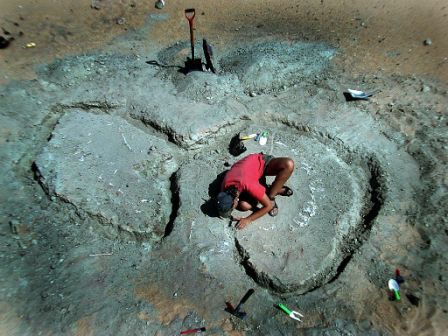Fossils of the Early Cretaceous dinosaur, Nigersaurus taqueti, document for the first time the cranial anatomy of a rebbachisaurid sauropod. Its extreme adaptations for herbivory at ground-level challenge current hypotheses regarding feeding function and feeding strategy among diplodocoids, the larger clade of sauropods that includes Nigersaurus. We used high resolution computed tomography, stereolithography, and standard molding and casting techniques to reassemble the extremely fragile skull. Computed tomography also allowed us to render the first endocast for a sauropod preserving portions of the olfactory bulbs, cerebrum and inner ear, the latter permitting us to establish habitual head posture. To elucidate evidence of tooth wear and tooth replacement rate, we used photographic-casting techniques and crown thin sections, respectively. To reconstruct its 9-meter postcranial skeleton, we combined and size-adjusted multiple partial skeletons. Finally, we used maximum parsimony algorithms on character data to obtain the best estimate of phylogenetic relationships among diplodocoid sauropods. Nigersaurus taqueti shows extreme adaptations for a dinosaurian herbivore including a skull of extremely light construction, tooth batteries located at the distal end of the jaws, tooth replacement as fast as one per month, an expanded muzzle that faces directly toward the ground, and hollow presacral vertebral centra with more air sac space than bone by volume. A cranial endocast provides the first reasonably complete view of a sauropod brain including its small olfactory bulbs and cerebrum. Skeletal and dental evidence suggests that Nigersaurus was a ground-level herbivore that gathered and sliced relatively soft vegetation, the culmination of a low-browsing feeding strategy first established among diplodocoids during the Jurassic.

Partial skeleton of Nigersaurus taqueti (MNN GAD517) discovered during the 2000 Expedition to Niger. Expedition member G. Lyon is seated inside the curve of the proximal caudal vertebrae of a skeleton planed flat by wind-blown sand at a site in Gadoufaoua, Ténéré Desert, Niger (photo by M. Hettwer).
![The diagram is based on strict consensus of five minimum-length trees using 13 ingroup taxa and 102 unordered characters (CI = 0.76; RI = 0.78) (Text S5). Scaled icons represent a diplodocid (Apatosaurus) [11], dicraeosaurid (Dicraeosaurus) [51], and a rebbachisaurid (Nigersaurus). Geographic distributions include Laurasian diplodocoids (western North America—Apatasaurus, Diplodocus, Suuwassea; Europe—Histriasaurus, Spanish rebbachisaurid) and Gondwanan diplodocoids (South America—Cathartesaura, Limaysaurus, Zapalasaurus; Africa—Rebbachisaurus, Nigersaurus). Temporal boundaries based on a recent timescale [52]. Color scheme: Laurasia (orange); Gondwana (blue); North America (solid orange); Europe (striped orange); South America (blue); Africa (striped blue). doi:10.1371/journal.pone.0001230.g004](http://worldfossilsociety.org/wp-content/uploads/2013/03/121219174150-large8.png)
The diagram is based on strict consensus of five minimum-length trees using 13 ingroup taxa and 102 unordered characters (CI = 0.76; RI = 0.78) (Text S5). Scaled icons represent a diplodocid (Apatosaurus) [11], dicraeosaurid (Dicraeosaurus) [51], and a rebbachisaurid (Nigersaurus). Geographic distributions include Laurasian diplodocoids (western North America—Apatasaurus, Diplodocus, Suuwassea; Europe—Histriasaurus, Spanish rebbachisaurid) and Gondwanan diplodocoids (South America—Cathartesaura, Limaysaurus, Zapalasaurus; Africa—Rebbachisaurus, Nigersaurus). Temporal boundaries based on a recent timescale [52]. Color scheme: Laurasia (orange); Gondwana (blue); North America (solid orange); Europe (striped orange); South America (blue); Africa (striped blue).
doi:10.1371/journal.pone.0001230.g004
Citation: Sereno PC, Wilson JA, Witmer LM, Whitlock JA, Maga A, et al. (2007) Structural Extremes in a Cretaceous Dinosaur. PLoS ONE 2(11): e1230. doi:10.1371/journal.pone.0001230
Academic Editor: Tom Kemp, University of Oxford, United Kingdom



 March 24th, 2013
March 24th, 2013  Riffin
Riffin  Posted in
Posted in  Tags:
Tags: 